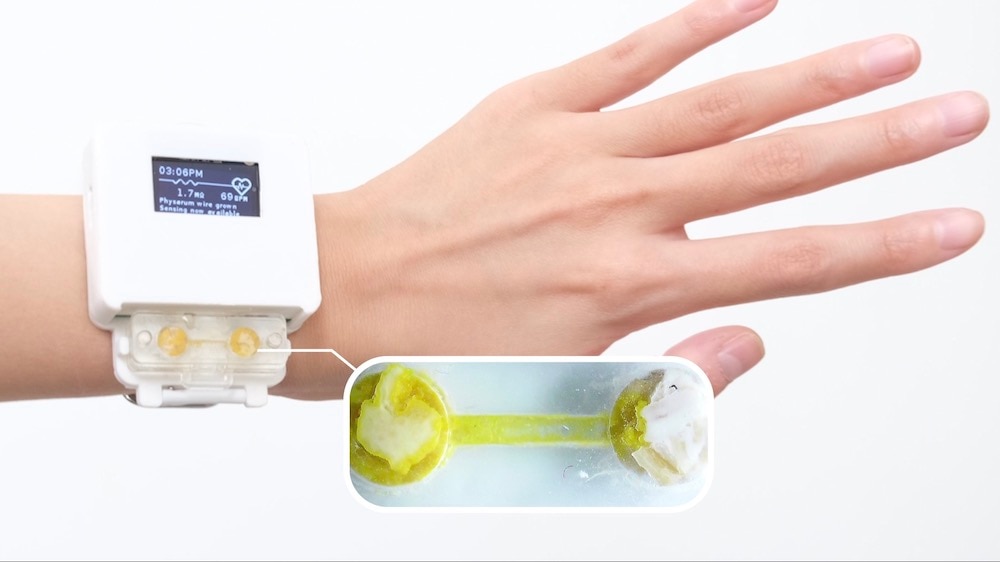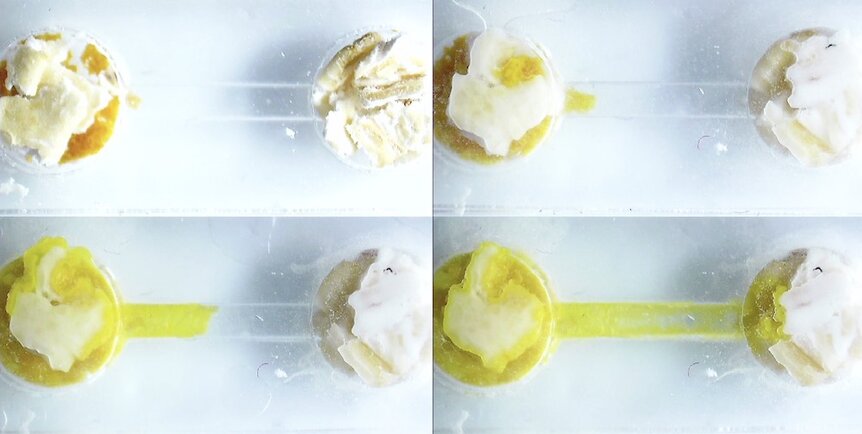Create a free profile to get unlimited access to exclusive videos, sweepstakes, and more!
A slime mold turns your smartwatch into a living Tamagotchi
This time if it dies, it's for real.

In 1996, the folks at Bandai presented the world with one of their most beloved and nostalgia-inducing creations: the Tamagotchi. If you were a kid in the ‘90s it’s incredibly likely you had a Tamagotchi or one of its many competitors. By 1997, more than 70 million Tamagotchis had been sold worldwide. There was just one problem, according to Bandai: They found that their digital pets were way more popular among kids who like traditionally feminine toys. It seemed they were missing out on a considerable portion of the market. So, they repackaged their digital pet into something a little flashier, with harder edges and more aggressive creatures. The result was Digimon, which started as its own line of virtual pets before transitioning into the wildly popular animated series (including Digimon Adventure Tri, which is streaming right now on Peacock).
Part of what made these toys and the stories they inspired so intriguing was the concept of a pet you could take with you everywhere you go. It didn’t require much maintenance, just a little food every now and again, maybe some water and a little cleaning up after. And in exchange you had a pocket friend, something which chirped at you happily and seemingly went through a life cycle. It also meant you had something which died if you didn’t check in with it and give it care. You were responsible for it.
RELATED: Tamagotchi revival lets you put a ring on it with new breedable pets
For a brief moment in time, we glimpsed the possibility of a world in which we maintained meaningful if limited relationships with our technology. Sadly, most Tamagotchis have since been discarded. Some 70 million digital lives snuffed out by neglect or failed batteries. It was probably inevitable, there was only so much you could do with a Tamagotchi and the novelty of it was bound to wear off. Besides, even the most diehard caretakers knew, in the back of their minds, that the Tamagotchi wasn’t real. Chucking it in a drawer didn’t really have an stakes. But what if it weren’t digital? What if your devices were really alive, at least a little bit, and you had to care for them in order for them to work?
That’s the question Jasmine Lu and Pedro Lopes, both from the University of Chicago, set out to answer in a new paper titled Integrating Living Organisms in Devices to Implement Care-based Interactions. Much of the work which happens in Lopes' lab involves virtual reality and the ways in which we can make a digital world more like the real one. They've experimented with things like VR headsets that move your head for you, and chemical haptics to provide sensations like heat, cold, or pain. This time, they're taking their work out of VR and into the real world. In this study, they designed a smartwatch with a living slime mold inside it. The watch displayed the time and was capable of measuring your heart rate, but only if the slime mold is healthy. In short, if you want to get full functionality out of the watch, you need to feed it, water it, and make sure it’s happy, not unlike the Tamagotchis we grew up with.
“Throughout the project we got comparisons and kept going back to the idea of the Tamagotchi. When I was a kid, I had a Tamagotchi on me all the time,” Lu told SYFY WIRE. Lopes continued, “It was that question from day one. Surely you can do this with a digital entity, but does it change anything if it’s not virtual. If you look and there’s this thing you’re growing and it’s organic, does that change anything? That was our intuition from day one and the participants say it does. It seems like humans do care about that.”
Participants of the study were each provided a smartwatch with their own Physarum polycephalum slime mold inside a cartridge on one edge. The cartridge is the slime mold’s enclosure but it’s also an important part of the way the watch functions. Upon first receiving the watch, participants had to begin a care regimen for their little glob of slime. Twice a day it needed to be watered, and every two days it needed to be fed oats. Vibrating alerts from the watch notified users at the appropriate intervals.
When the slime mold is cared for, it reaches out from its starting point and grows across a narrow channel in the cartridge. Eventually it reaches the other side and its body serves as a wire which completes a circuit and activates the heart sensor.
“That only happens when it’s healthy. If it dries out because you’re not providing water or oats, the wire is no longer conductive and the heart rate sensor is no longer provided,” Lu said.
From an engineering perspective, this relationship comes down to connectivity. When a slime mold is healthy its body offers less resistance and allows electricity to flow. When it dries up, it becomes more resistant, and the flow of electricity is halted. The smartwatch was designed to operate at the conductivity level present when the slime mold is healthy.
From a human perspective there’s something else going on, at least that’s what Lu and Lopes suspect. The researchers were careful not to use leading words at the start of the study. They never used words like “alive” or “organism” and they didn’t make any comparisons to Tamagotchis to the participants. Still, the people wearing these watches made those connections on their own, especially during the second phase of the study.
For the first week, participants were asked to diligently care for their slime molds as instructed by the watch. After a week, they were asked to discontinue any care routine for the remainder of the study. Then they did a series of interviews to ask participants how their relationship with the smartwatch compared to other wearables, how it compared to plants or pets, and how they would go about disposing of their watch if and when they needed to.
“People struggled with it a lot. Some said they would try to rehome it because they thought it was similar to a pet. Some said they felt responsible for it and they wouldn’t feel comfortable disposing of it at all,” Lu said.
Lopes continued, “Some talked about how they eat the same things as a slime mold, they eat oats too so already they feel like they’re closer to this thing than a regular electronic device. Others talked about bidirectionality, they give the slime mold something like water and it gives them something back in the heart rate monitor. My smart phone performs functions for me but I never perform a function for it.”
There’s something a little bit beautiful about that sort of relationship. Suddenly, by virtue of this organism living inside the watch, the entire device becomes something a little more real. You find yourself caring about your possessions in a way that’s uncommon to our ordinary experience. One could imagine an alternative future in which all of our devices have something living inside them. Suddenly, your relationship with your television, your cell phone, or your car becomes a little more robust. There’s a reciprocity which doesn’t exist in our modern disposable culture of single-use items. If we lived in that world, we might find that we take better care of our things and feel more connection with the world around us. We might also find that we’re more discerning about what we buy. That novelty waffle iron makes waffles in the shape of the death star, but do you actually want one more thing to take care of?
“I’m really interested in the ways we can design new technologies which allow us to question our relationship with technology and contribute new relationships. How can the future of tech be designed so that people feel like they have a stake in it and can interact in different ways,” Lu said.
Sadly, the slime mold smartwatch probably isn’t coming to store shelves near you. The point of the study was to explore these relationships, not to design a consumer product. But maybe it should have been. We might all be well served by reconsidering the ways in which we interact with technology. Maybe all of those Tamagotchis didn’t have to die in vain.




























